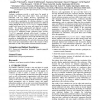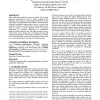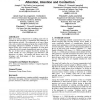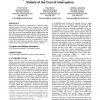CSCW
2004
ACM
14 years 5 months ago
2004
ACM
The status quo for co-located groupware is to assume that “social protocols” (standards of polite behavior) are sufficient to coordinate the actions of a group of users; howev...
CSCW
2004
ACM
14 years 5 months ago
2004
ACM
We introduce a system that allows four users to each receive sound from a private audio channel while using a shared tabletop display. In order to explore how private audio channe...
CSCW
2004
ACM
14 years 5 months ago
2004
ACM
CSCW
2004
ACM
14 years 5 months ago
2004
ACM
Collaborative authoring is a common workplace task. Yet, despite improvements in word processors, communication software, and file sharing, many problems continue to plague co-aut...
CSCW
2004
ACM
14 years 5 months ago
2004
ACM
Academic conferences provide a social space for people to present their work, learn about others’ work, and interact informally with one another. However, opportunities for inte...
CSCW
2004
ACM
14 years 5 months ago
2004
ACM
Often collaborative graphical systems lag behind well accepted single-user applications in terms of features supported. The frequently used operations of group/ungroup offered by ...
CSCW
2004
ACM
14 years 5 months ago
2004
ACM
There are a variety of digital tools for enabling people who are separated by time and space to communicate and collaborate on shared interests and tasks. The widespread use of so...
CSCW
2004
ACM
14 years 5 months ago
2004
ACM
We present contextual collaboration, an approach to building collaborative systems that embeds collaborative capabilities into core applications, and discuss its advantages. We de...
CSCW
2004
ACM
14 years 5 months ago
2004
ACM
Interest has been growing in opportunities to build and deploy statistical models that can infer a computer user’s current interruptability from computer activity and relevant c...
CSCW
2004
ACM
14 years 5 months ago
2004
ACM
In this paper, we describe the evolution and impact of computersupported cooperative work (CSCW) research through social network analysis of coauthorship data. A network of author...




